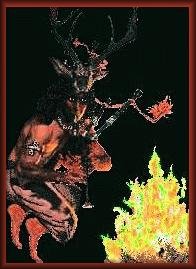|
|
|

|
|

IMBOLC (1st of February): This is the first
day of spring, mid-way through the dark half of the year. Brigantia (Brigit),
goddess of all creative activity, rekindles the fire in the earth, preparing
it for the re-emergence of green things. This stirring of new life is manifested
by the first flowing of milk in the udders of ewes, a few weeks before
the lambing season. Agricultural tools are re-consecrated for use, household
fires and the fire of the smith's forge are blessed by the goddess (often
by a woman who plays the role of Brigit), end talismans of rushes,
"Brigit's crosses," are made for the protection of homes. Brlglt's snake
comes out of the mound in which it hibernates, and its behavior is thought
to determine the length of the remaining period of frost (Americans
will recognize this as the origin of "Ground Hog Day"). In the Brythonic-speaking
lands, Brigantia has come to be assimilated into the Virgin Mary, leading
to such names for the feast as Welsh Gwyl Mair Dechrau'r Gwanwyn
('Feast of Mary of the Beginning of Spring'); and Breton Gouel Varia
ar Goulou ('Feast of Mary of the Light') -- although Welsh also uses
the term Gwyl Ffraed ('Brigit's Feast'). In modern Gaelic the name La
Fheile Bride, meaning 'Brigit's Feast Day' (Manx: Laa'l Breeshey)
is more commonly used than Oimealy.

BEALTAINE (1st of May): On this day the year
begins its bright summer half. The event is associated with the myth of
a young Summer God released from captivity, or with that of a young Summer
Maiden wooed away from her retentive earth-giant father. In some areas
a hawthorn tree (representing the giant) is cut down and used as a maypole.
The festival has come to focus primarily on the figure of Belenos, a god
of light and healing with a special affinity for cattle. Cattle are driven
between the sacred bonfires to protect them from disease hence the name
of the feast, Bel-t/ne, 'fire of Bel(enos).' The Brythonic names of the
feast (Welsh, Calan Mai - Cornish, Calan Me - Breton, Kala-Mae)
mean 'First Day of May.'
LUGHNASADH (1st of August): Before the harvest can begin, the greedy Fomorian earthspirits must be persuaded to relinquish the fruits of the soil to human use. It is the great god Lugh (or Lieu) who accomplishes this, since he is kin to both the gods of the tribe and the giants of the earth. He dies, is resurrected, and gains the victory over the Fomorians. This long festival season is marked by rituals to ensure a successful harvest, pageants to commemorate the story of Lugh, and various communal pastimes -- horse races, sporting events, fairs -- that bring together the scattered households and reinforce the identity of the tribe.